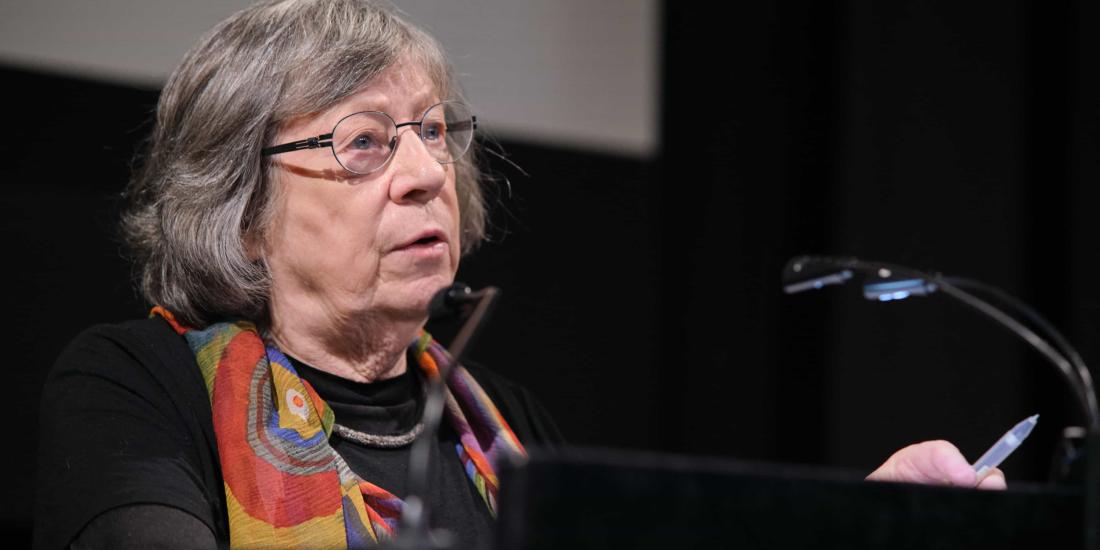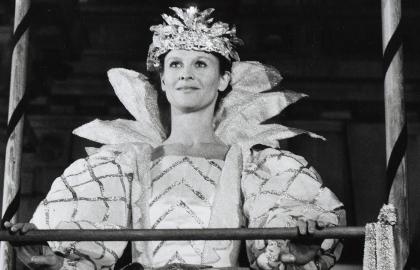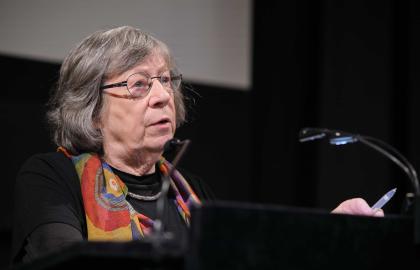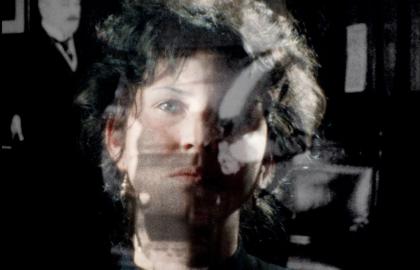Mulvey’s writing and discourse is typically shaped by exchange, whether it’s trading ideas with other makers and thinkers or collectively reading texts. She called her own reading group History Group, or sometimes, the Feminist Studies Group. Ours is called Ursula and we are, in fact, a collective of female film-makers. Mulvey considers Visual Pleasure and Narrative Cinema to be an exploratory text. One that arose amidst, or around, a rich and emerging experimental film context. It only seems natural, therefore, that a female collective should revisit it today. Ursula is about people looking, thinking and organising things together. Structuring ourselves around Mulvey’s text demonstrated – in no uncertain terms – that communal reading can be a source of marvellous insights.
In the years preceding the essay’s publication, Mulvey encountered the work of Joyce Wieland, Yvonne Rainer and Chantal Akerman. In these women, she discovered powerful voices that demonstrated just what a counter-cinema could be. Counter-cinema as an essential rebuff to an overly male and largely one-sided viewpoint. In other words: to avert John Berger’s male gaze. Mulvey introduced this term and it was immediately enshrined in the film studies canon. In her text, the film scholar wanted to subvert the voyeuristic and fetishistic pleasure of watching that mainstream cinema took for granted. She showed that (individual) male spectators and male actors are the bearers of the gaze, while women in film are forever its recipients. Mulvey also proved that the sexist status quo – both in society and Hollywood’s output in the 1940s and 1950s – was not just self-perpetuating but also mutually reinforcing. She drew upon Freud’s and Lacan’s theories about looking and desire. This was because they had explored the theme in a psychoanalysis that excluded women from the ‘symbolic order’ of the world in which meaning is created. Psychoanalysis was soon accused of phallocentrism, which helped Mulvey to expose the identical structures in cinema. In other words, Hollywood and Freud were good bedfellows.
In our discussions, we quickly agreed that the cinema Mulvey wanted to replace is still alive and kicking. And moreover, we conceded that classic narrative cinema, with all its calibrated power structures and role patterns, is the same as it ever was (despite a handful of trendy tweaks). Wieland, Rainer or Akerman never really managed to escape the term ‘counter-cinema’ in that same timeline. And while Akerman subsequently topped Sight and Sound’s decennial poll, it was not because she had suddenly expressed herself in a style that stirred the masses. She transcended categories and maintained a non-conformist style that has only served to strengthen her oeuvre over the years. Mulvey is no less uncompromising. The hope for a new cinema rests, in her eyes, on the ‘total negation’ of classical narrative, which is what Akerman achieved in the majority of her work. And whenever there was a story to be told, she fought against every convention with all her might.
Feminism, strong women & Hollywood
Total negation sounds intense. Where does it lead? Two days before our Mulvey discussion, Ursula founder Alex Schuurbiers invited researcher Marion Wasserbauer to give a short lecture entitled feminism 101. We collectively reflected on the myriad meanings of the term ‘feminism’. It is evident that ‘feminism’ covers a broad field. For some, it corresponds to what we might now describe as ‘woke’, while for others, it has a more purist slant that is limited to women’s place in the world. More pluralistically, this can equate to social equality. The ‘intersectional’ path that feminism is treading is a promising one. The movement overlaps with other causes in a collaborative fight against inequality, from the perspectives of the various standpoints. Feminism that distinguishes on the basis of race, class, gender, religion or disability is, in this context, an immature variant. Time has fortunately shown that feminism is a agile form of activism that both learns and corrects. In a 2018 interview for Another Gaze, Mulvey commented on her 1975 essay: “In the years since, I’ve thought of questions of race and the invisibility of African American performers and talent in Hollywood and how it was really an apartheid cinema.”
Her feminism is no less agile. Moreover, it is never about denying or rejecting a past, but rather about discovering new art forms, new boundaries or a new ‘language of desire’, because it goes without saying: images are lusted over like never before. It is high time, therefore, to make sure that images do not preserve the same-old ideologies and structures, because all too often feminism means that women just do whatever men do. And there’s a grain of truth in this: women can also be power-hungry, nasty pieces of work. One only has to think of Hillary Clinton and Margaret Thatcher or, in the film universe, Lydia Tár.
Tár, Todd Field’s film starring Cate Blanchett as a lesbian conductor who appears to abuse her position of power, was not universally understood or appreciated. Surely, ‘in the midst’ of female emancipation, you cannot portray women, let alone queer ones, in such a way i.e. as having the same traits as the male top dog: hunger for power, rampant ego and the capacity to lie. The film did not intend to secretly discredit women, however, but to serve as a reflection on power.
It’s great that women are finding the self-confidence to stride through life in the shoes that suit them best – be it clumpy boots or stilettos – but there is a need, above all, for less foot stomping. Béyonce, for example, is trying to prove herself in a world determined by neoliberal, ultra-capitalist standards, with its immense focus on individual success and status. Exploiting others is an undeniable part of this trajectory, which only perpetuates inequality. Beyonce’s brand of seemingly benevolent and proselytising girl-power feminism soon acquires a bitter aftertaste.
Feminism that aims to smash glass ceilings, rise above others, and that actually thinks like a man – or at least through ‘man’ as a social construct – has little to do with femininity (which is yet another social construct). This is where feminism misses the mark. The problem that Mulvey identified in a homogeneous, illusory cinema – men in active roles and women in passive ones – is easily reversible without a radical change in the underlying (power) structures. For Mulvey, it was a ‘layer’ on top of voyeurism, fetishism and the viewer’s identification with what he/she/they see on screen. At this juncture, however, it is crucial to think more in that third layer: in terms of power. In her book On Women, Susan Sontag reiterated Virginia Woolf’s words from the 1930s: “the fight to liberate women is the fight against fascism”. Both writers were ahead of ‘intersectionality’ in concluding that there can be no distinctions in ‘freedom’. No one is free until everyone is free.
Liberating cinema
Liberating cinema, and by extension all visual culture, from its inherent power structures is a good, anti-fascist beginning. For Mulvey, freeing cinema is akin to “leaving the past behind without rejecting it, transcending outworn or oppressive forms, or daring to break with normal pleasurable expectations in order to conceive a new language of desire.” By discovering a completely new language of desire, by diffusing the gaze, she touches on what Sontag deduced in (written/spoken) language, namely that sexism or patriarchal thinking is embedded in its syntax/grammar. It is this that needs to be chipped away at before we can change how it’s used.
Mulvey suggests doing (and continuing to do) the same for cinema. Here too, we have to look at the essential building blocks, such as time, space and defining the gaze: “To free the look of the camera into its materiality in time and space and the look of the audience into dialectics, passionate detachment.” The objective is to distort all existing relationships between image and viewer, to disrupt voyeurism and the process of identification. Classic active-passive relationships in narrative cinema are too dominant, too easy, too one-sided and have too great an impact on contemporary visual culture, which is far broader and deserves to be written about more extensively and deeply. Society, meanwhile, has redoubled into a digital sphere wherein almost everyone suffers from scopophilia (‘pleasure of looking’) and where the illusionistic power of cinema permeates the daily stream of images via social media or series without end.
Despite all this... it is not necessary to forsake Hollywood and other forms of conventional cinema. Like Mulvey and Ursula you can be (and remain) one of its fans. But films that currently call themselves feminist are often just happy to tick all the familiar checkboxes in reverse, without touching the structure. Down with those boxes, Mulvey said back in the 1970s, keenly, loudly and relentlessly. Subversion!
Around the table: Jana Coorevits, Ans Mertens, Chloé Op de Beeck & Kathy Vanhout
-
With enriching depth and thoughtful analysis, the collaboration with Fantômas contextualises the cinema programme and provides an anchor for the viewer.






